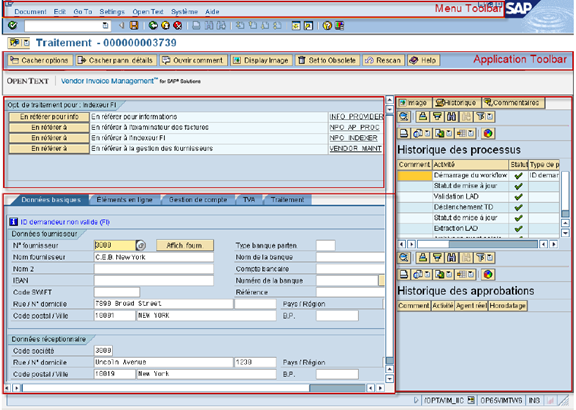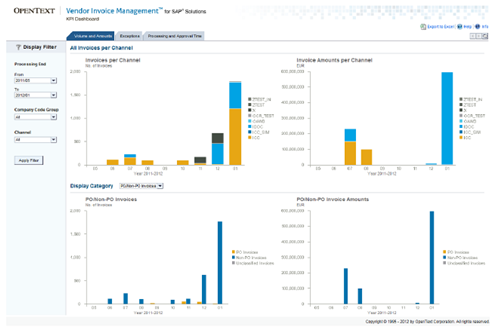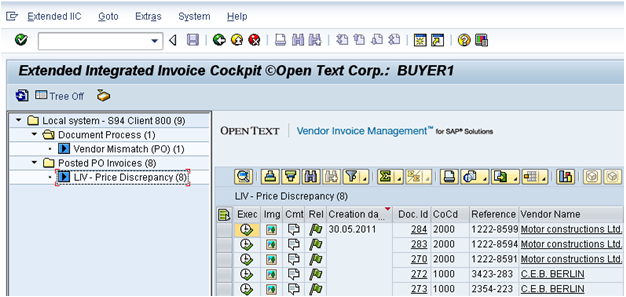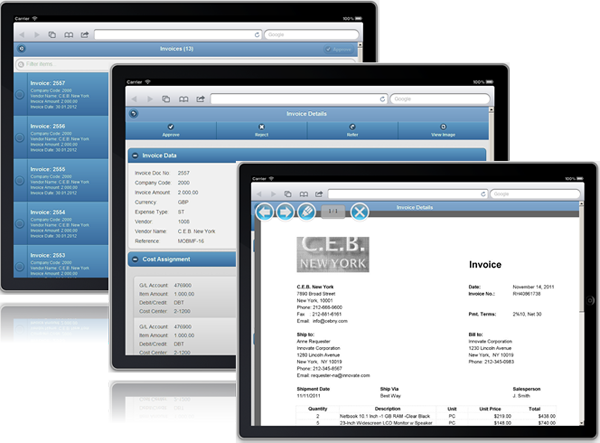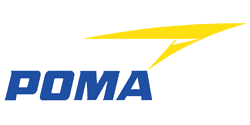“Dematerialize, optimize, make profitable your supplier invoice management”
Managing invoices is a difficult task for many companies. As companies become increasingly global, the approval process has become increasingly complex. To make matters worse, approved invoices often contain incorrect or incomplete information, which can lead to late payment penalties or supply chain disruption. Add to this the cost associated with photocopying and distributing paper invoices, and everyone will agree:
traditional invoicing is complex and expensive. It’s time to dematerialize your supplier invoices!
SAP Invoice Management by OpenText (SIM), also known as Vendor Invoice Management (VIM), covers the entire Purchase-to-Pay process, from the purchase of goods and services to the payment of suppliers :
The SAP Invoice Management (SIM) solution enables the above.
Track the performance of your solution
- Measure the performance of your processes: Track actions and their deadlines directly from SAP.
- Different reports: Daily monitoring, monthly or annual reports. Several axes of analysis are provided to meet a maximum number of needs around the solution.
- Reports integrated into BW : Take advantage of SIM reports in the SAP data analysis tool
Mobile invoice processing
- Multi-support validation: Validate your invoices from the tool of your choice.
- FIORI compatibility: Take advantage of the new SAP FIORI ergonomics that adapt to the browser used.
- Validate and much more: Why settle for FIORI validation? Manage anomalous invoices directly in dedicated FIORI applications
Implementing a solution such as SAP Invoice Management enables your accounting teams to focus on value-added tasks
SAP Invoice Management is a solution published by OpenText and available in the SAP solutions catalog through a worldwide partnership that has existed for over 20 years. As SIM is an SAP add-on, the solution is seamlessly integrated with SAP, making it totally transparent to your SAP users.
SAP Invoice Management simplifies the processing of your invoices by automatically matching them with orders from SAP or, for invoices that have not been the subject of an order, by proposing approval workflows. The benefits are numerous:
- Accelerate accounts payable operations at all levels of the company through integration with SAP ERP.
- Improve productivity and sales by automating routing, approval and payment processes.
- Optimize cash flow by streamlining workflows, sending reminders and accelerating the payment cycle.
- Ensure fast, accurate financial reporting with automatic access to accounts payable information.
- Promote regulatory compliance with a well-managed accounts payable process using pre-configured rules.
- Improve supplier relations with easier access to accurate, up-to-date information.
March 2021: New features in version 7.6 (ECC6) / 20.4 (S/4HANA)
SAP Invoice Management is a solution published by OpenText and available in the SAP solutions catalog through a worldwide partnership that has existed for over 20 years. As SIM is an SAP add-on, the solution is seamlessly integrated with SAP, making it totally transparent to your SAP users.
SAP Invoice Management simplifies the processing of your invoices by automatically matching them with orders from SAP or, for invoices for which no order has been placed, by proposing approval workflows. The benefits are numerous:
- Accelerate accounts payable operations at all levels of the company through integration with SAP ERP.
- Improve productivity and sales by automating routing, approval and payment processes.
- Optimize cash flow by streamlining workflows, sending reminders and accelerating the payment cycle.
- Ensure fast, accurate financial reporting with automatic access to accounts payable information.
- Promote regulatory compliance with a well-managed accounts payable process using pre-configured rules.
- Improve supplier relations through easier access to accurate, up-to-date information.
Discover the list of principal new features
March 2021 – New VIM Opentext version
A major new version of SAP Invoice Management by OpenText (SIM or VIM) was released in October 2020. This new version 7.6 (for SAP ECC6 customers) or 20.4 (for SAP S/4HANA customers), brings numerous enhancements:
- changes to license rights to extend the scope of functionality,
- technical improvements to workflows and interfaces,
- new automation functions designed to help companies increase their return on investment.
With this new release, SIM/VIM users are able to drastically improve efficiency, increase their integration capability and extend their use of the solution beyond finance, via packaged extensions
These updates also serve to align the SIM/VIM roadmap with SAP’s overall strategy, in particular the SAP Fiori roadmap and the SAP S/4HANA roadmap, whether for On-premise or Cloud environments.
What’s new in VIM
VIM lifecycle
In October 2020, OpenText released the latest versions of VIM. For SAP ECC6, the current version is now 7.6, and for SAP S/4HANA, you can upgrade to version 20.4. Both versions should be supported until 2025, with two new releases planned each year.
If you’re still using SAP ECC 6.0, keep in mind that it will be fully supported until 2027, but many new automation and machine learning features to come will not be compatible as they will rely on the S/4HANA platform.
Keep this in mind when considering your immediate upgrades and updates to your VIM solution: today’s initiatives could simplify your migration approach later, this by opting for a smooth transition.
Changes to the scope of license usage
The first change came in March 2020, when OpenText informed all existing VIM customers of an important change to the scope of use covered by the licenses. In a nutshell, the message was: “VIM customers now have the right to use all SAP Digital Content Processing by OpenText Solutions workflows”. From now on, VIM licenses will cover all integration flows for sales orders, quotations, order confirmations and delivery notes, not just supplier invoices. The metric for VIM licenses is now the number of “documents”, not the number of “invoices” processed annually by the solution;
From now on, VIM licenses can be used to integrate all types of documents into SAP!!!
This change applies to both new and existing customers.
VIM Solution and VIM Beyond finance
In October 2020, OpenText released an update to the solution that provided the necessary functionality to take advantage of the license change.
In fact, OpenText’s Vendor Invoice Management (VIM) 7.6/20.4 now includes the power of the Digital content Processing (DCP) solution. This merger of applications enables companies to use fully automated digital processes beyond the traditional accounting aspect of VIM, in a wider range of business documents.
In effect, OpenText has transformed VIM into a powerful document automation platform they now call VIM Beyond Finance. This platform is capable of processing invoices, order confirmations, delivery notes, sales orders and more. Many organizations are already taking advantage of this enhanced ability to manage new business flows.
The bottom line is that existing VIM customers can now extend their solution by building on their existing platform, and new customers implementing VIM for the first time are able to use it for a much wider range of use cases.
In both cases, VIM’s established workflow model is used to automate the processing of incoming documents in their paper, fax, e-mail or EDI form, or as part of a more advanced portal or platform, such as SAP Ariba, COUPA or GEP’s SMART Source-to-Pay.
This enables a company to flexibly use each source channel as it grows and matures, without having to implement additional solutions.
Extended robotization capability (RPA)
One of the strengths of an intelligent solution is its ability to leverage Robotic Business Automation (RPA) for many of the tedious tasks required throughout the process. With this update, VIM extends its automation capability with SAP iRPA (Intelligent RPA), providing additional integration points in VIM for calls in conjunction with an RPA solution. For example, in a sales order process, the system can use an RPA Bot to retrieve an e-mail from an inbox, retrieve the sales order within it, and capture it in the VIM system.
It can then assess whether to archive the document, send it to OCR or send it within a more complex business rules framework.
Once it publishes or creates the sales order, another RPA bot can send an update to the CRM system, update an Excel file and trigger an e-mail confirmation to the account manager of the organization that created the sales order.
The possibilities offered by the solution for saving time and eliminating simple manual tasks are endless with this type of automation. And they can translate into hundreds of thousands of minutes saved every year within a large organization.
VIM ENHANCEMENTS
This update includes a wide range of technical updates, process improvements and functional additions that enhance the overall capability of the VIM solution. Below are some of the main additions (this list is not exhaustive, please contact us for more details on these features).
Manual selection of invoices for videocoding
One of the process enhancements in the 7.6/20.4 update is the ability to easily trigger OCR validation on individual documents, from a validation cockpit in SAP. Traditionally, the invoice reading validation process is a first-in, first-out flow where all documents are queued and the AP team addresses them one by one in the order they were received.
With this update, VIM provides a validation cockpit where all documents in ‘Ready for Validation’ status are available. This cockpit contains an ‘Execute’ function which opens the validation client screen and allows instant access to validation on any invoice, according to your needs.
This allows processors to prioritize urgent invoices that need immediate attention In concept, this seems like a simple change, but it provides a substantial amount of flexibility that allows actors to organize and prioritize document processing according to their business need.
New ” Smart coding ” feature
A new feature available in this update is targeted at invoices without orders, and is called Smart Coding. In the past, we used automatic coding (“Auto-coding”), which allowed administrators to predefine charge values for certain combinations of supplier and company codes. The new Smart Coding function extends this functionality, with advanced machine-learning algorithms that detect similar invoices natively and without human intervention. The system then proposes accounting lines based on past experience, with a confidence index.
When a GL account is identical, but the cost center is unclear, the system can present several choices ranked according to how often they appear and how they have been used in the past for this supplier. Once an automatically-proposed allocation choice reaches a confidence level of 100%, administrators can configure the system to propose it automatically, without prompting the user for the entry or allocation stage, and send the invoice directly to an approver.
Smart Coding functionality is also available in the FIORI application for allocating invoices without an order.
In-line translation
VIM Version 7.6/20.4 also includes a new function that enables the system to translate user comments into other languages.
Most often required in large companies, this is invaluable for international organizations with users who share responsibility for the same process in different regions whose language of use is not the same.
Thanks to this new feature, users can easily add and read comments with translations provided in the solution, whether via SAP GUI or Fiori interfaces.
Of course, administrators need to integrate VIM with a translation service such as Bing Translate, Google Translate. Prices for translation services can vary depending on factors such as translation volume, languages and timing, but there is a range of options to suit most usage requirements and budgets.
Business partner identification
In the previous version of Intelligent Capture, there were difficulties in determining the supplier or customer business entity for supplier invoices or sales orders. The problem was rooted in the fact that the previous capture solution did not fully utilize address-based search (which is specific to the ICC/BCC solution, but has been transposed into the new version of Intelligent Capture).
Beyond taking advantage of the IBAN or Tax ID to determine the supplier ( these are often not listed on a US-based invoice, even though they are common in Europe), the new V7.6 and 20.4 update refines the logic of the back-end system by improving and automating the way suppliers and customers are determined. As a result, this enables more accurate determination of business entities for US and European sources.
There’s also an advanced machine learning component. So if the system can’t find a business entity, it’s very easy to train it so that the integration of subsequent invoices doesn’t pose a problem of business entity or supplier recognition.
Transferring training data
Although Intelligent Capture was able to migrate old BCC training data to a new solution, it did not have the capability to import additional training data after configuration. This was a barrier to efficiency, as many companies hoped to re-use quality systems to test and train their solution on high-volume suppliers before going live, or on a non-productive system. They didn’t want to have to start from scratch in their production environment.
With the latest version, companies can easily import training data, enabling them to begin training on supplier and document scenarios early in the development process. Then, as part of the go-live switchover, they can transfer the entire training data set into the production environment. This saves a lot of work and enables a much more efficient learning and upgrading process.
Page-based extraction control
A common use case that the previous capture solution was unable to handle in the past was when only a few pages of a submitted document needed to be captured. Cover pages, detailed security instructions, closing pages all add time-consuming extra pages that artificially increase the number of documents to be captured (even if they are not important for the commercial use of the documents).
To solve this problem, the capture solution can now limit OCR extraction on documents, according to a certain number of pages, instead of automatically capturing the complete document: indeed, it is now possible to choose to extract X number of first pages and/or X number of last pages.
For example, it is possible to configure the system to extract the first 2 pages and the last 2 pages of each document. This control increases efficiency and reduces the total capture time per document.
New PDF extraction mode
There’s also a new extraction mode for PDF documents that allows OCR to skip e-text pages. This allows the system to interpret text embedded in the PDF, instead of scanning and reinterpreting an entire page. This reduces capture time, as well as the volume of data from the complete document in the system.
Interpreting Patch Code sheets
Patch codes are unique barcode templates used to facilitate the efficient scanning of batches of documents. They provide instructions to the scanner on how to organize and group specific pages in a stack of documents. Although this practice is becoming less common as paper-based processing is replaced by electronic submission, some regions still rely on it. In response, Intelligent Capture can now read and interpret patch code sheets, and stop OCR for documents that don’t need to be captured.
Extended Fiori management
SAP Fiori is the user experience layer of SAP applications. It has not been overlooked in the latest VIM 7.6/20.4 updates. To date, there are two generic applications, eleven VIM-specific tiles, fifteen P2P and O2C targeted tiles, and twenty ODATA analytical data sources. This means that Fiori tiles and the sophisticated, streamlined experience they provide will continue to be an integral part of the VIM environment for years to come.
Fiori Analytics
An important note to understand in this release relates to Analytics Tiles. In a strategic decision, OpenText does not provide specific Fiori Report Tiles for analysis, but provides the data streams that can be consumed to provide analytical data. This allows customers to choose all Fiori Analytics tools and configure applications in response to their specific needs. This allows better integration with SAP overview pages and enables information to be obtained and analyzed using native SAP S/4HANA tools.
Fiori Vendor Invoices Report
A new tile is available in VIM version 7.6/20.4. It’s called Vendor Invoices Report and is the equivalent of VIM Analytics in Fiori. This new report is not as extensive as VIM Analytics in SAP, but it provides similar functionality and displays the most important data and information.
Companies will be able to select and filter all invoices stored in VIM, and view invoice details, including fields, history, attachments, processing history and approval log.
This Report also supports semantic navigation to and from SAP applications, such as to the “Supplier Master” or to purchase order management.
Additional OCR analysis
Another recent update concerns extended OCR analysis. From VIM version 7.6/20.4 onwards, a new Report is available to provide an analysis of the capture stage and help understand how the OCR solution is performing. This is extremely useful for monitoring the system’s ability to perform OCR and pinpointing recurring issues with certain suppliers or document types.
Here are some of the data from the report:
Each of these features combines to provide a more efficient document capture process, less prone to error and allowing your teams to focus their time on higher value-added tasks.
References clients :
Every year, Applium carries out around ten projects implementing OpenText solutions for SAP, and provides corrective and evolutionary TMA for several user companies. Among the most recent are the following customers:
| Client | Version SAP | Activité | Périmètre | Nb factures/an | Prestations Applium |
| Adisseo | ECC6 | Animal Nutrition | France, Spain | 38 000 | Implementation, AMS |
| Eurolysine | S/4HANA 2023 On Premise | Animal Nutrition | France | 30 000 | Implementation, AMS |
| Boulanger | ECC6 | Retail | France | 455 000 | Implementation, AMS |
| Casino | ECC6 | Retail | France | 700 000 | Version migration |
| Centre Hospitalier Princesse Grace (CHPG) | ECC6 | Health | Monaco | 50 000 | Implementation, AMS |
| CS Group | S/4HANA 1909 | Service, Engineering | France | 20 000 | Version migration |
| Daher | ECC6 | Aerospace | France | 210 000 | Implementation |
| Dassault Aviation | ECC6 | Aerospace | France | 400 000 | Implementation |
| Fichet Bauche Télésurvaillance | ECC6 | Security Services | France | 2 000 | Migration, AMS |
| Financial SAVE | ECC6 | Fire detection and safety | France | 43 000 | Implementation, AMS |
| Jtekt | ECC6 | Automotive supplier | France | 90 000 | Implementation |
| Lactalis | S/4HANA 1909 | Dairy products | France, Germany | 600 000 | Implementation |
| Les Echos | ECC6 | Press | France | 20 000 | AMS |
| Mane | ECC6 | Fragrance | France, United States | 35 000 (France) 25 000 (US) | Implementation |
| Pierre Fabre | S/4HANA 1909 | Medicines | France | 140 000 | AMS |
| Plastic Omnium Auto Exterior | ECC6 | Automotive supplier | France, Belgium, Germany, Spain… | 100 000 | Implementation, AMS |
| Prisma Media | ECC6 | Press | France | 45 000 | Implementation, AMS |
| Régie des Transports Métropolitains | ECC6 | Transport | France | 30 000 | Migration, AMS |
| Truffaut | ECC6 | Retail | France | 300 000 | AMS |
| UGAP | S/4HANA On Premise | Public purchasing group | France | 2 000 000 | AMS |
| XPO Logistics | ECC6 | Logistics/transport | France | 435 000 | Migration |
Focus on Adisseo


